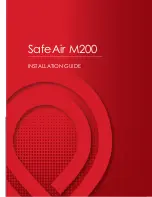
37
MARS
QUADCOPTER OPERATOR’S MANUAL
GLOSSARy Of TERMS
Binding:
The act of pairing the transmitter and receiver to prevent RF signal interference from transmitter’s operated
by other pilots.
Bind LED:
Displays the current operating status of the receiver.
Bind Plug:
Used in the process of binding the transmitter and receiver. The bind plug is installed onto the bind port
in the receiver to place the receiver in bind mode.
Brushless Motor:
The quadcopter features four brushless motors to power it for flight. Brushless motors don’t feature
brushes, so they are lighter, more efficient, more powerful and more durable and longer lasting than brushed motors.
Brushless Camera Gimbal:
A camera mount that is powered by brushless motors, which automatically keeps the
camera level in the pitch and rolls axes, and also allows you to remotely control the pitch axis of the camera.
Camera Gimbal Control Dial
: Controls the Pitch axis of the camera gimbal during flight.
Compass:
An electronic device that helps orientate the quadcopter during various phases of flight. The compass
must be calibrated correctly, otherwise the quadcopter will not fly correctly.
Control Sticks
- Stick gimbals on the transmitter that control the quadcopter’s Forward/Backward (Pitch), Right/Left
(Roll), Throttle (Power Up/Down) and Yaw (Spin Right/Left) flight axes.
Distance Limit:
The maximum distance (985 feet) the quadcopter can fly from the Home Point before the Failsafe
function activates.
ESC:
An acronym for Electronic Speed Control. This is an electronic device that controls the RPM of the motor
attached to it.
Failsafe:
A safety feature that commands the quadcopter to return to its Home Point and land should the quadcopter
exceed the altitude and/or distance limits or if the RF signal between the transmitter and receiver fails.
Firmware:
A low-level software program that controls how the quadcopter’s flight controller operates. Periodically,
updates to the flight controller firmware may be released that provide enhancements and fixes that improve flight
performance and user functions.
First Person View (FPV):
A method of flight often used to describe a camera mounted on a model which lets the
pilot see what the model sees in real time. This is done by way of video goggles or video screens which display the
output of the on-board camera.
Flight Controller:
An electronic device that comprises the gyros and accelerometers, in addition to other electronic
functions that enable the quadcopter to function and fly correctly.
Flight Mode Switch
: Used to change Flight Modes. Choose from Manual Mode (1), GPS Mode (2) and Return to
Home (3). Also used in the Compass Calibration process.
Flight Trimming:
The act of using the transmitter trim switches to make fine-tuned corrections to the controls, to keep
the quadcopter level during flight with no control stick input.
GPS:
An acronym for Global Positioning System. When used in a quadcopter, GPS is used to determine location,
track movement and hold position during flight.
GPS Flight Mode:
Uses the GPS system to provide Auto-Hover, Auto-Hover with Head Lock Position Hold and
Auto-Hover with Head Free Position Hold. Use the GPS Flight Mode to hold a desired altitude and position, allowing
you to control the camera gimbal to shoot amazing, stable aerial video.
Gyro:
An electronic device integrated into the flight controller that works in conjunction with the accelerometer to
help stabilize the quadcopter during flight.
Head Free:
An option within the GPS Auto-Hover and Position Hold functions, the forward flight direction is not
locked to the nose of the quadcopter. For example, if you spin the quadcopter right or left, then fly forward, the
quadcopter will fly forward in the defined direction, not in the direction the nose is pointing.
Head Lock:
An option within the GPS Auto-Hover and Position Hold functions, the forward flight direction is locked
to the nose of the quadcopter. For example, if you spin the quadcopter right or left, then fly forward, the quadcopter
will fly forward in the direction the nose is pointing.
Home Point:
A function of the GPS, the Home Point determines the location the quadcopter will fly back to when you
use the Return to Home function.






























